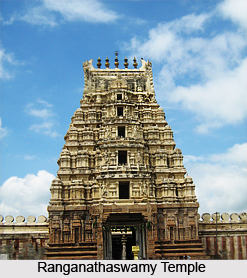 Tourism in Srirangapatna comprised of several mosques and temples, which were built during the time of Muslim Dynasty. Srirangapatna or Srirangapatna Island is also a town in the Mandya district of the Indian state of Karnataka. Srirangapatna Island is located near the city of Mysore, is the place of great religious, cultural and historic importance.
Tourism in Srirangapatna comprised of several mosques and temples, which were built during the time of Muslim Dynasty. Srirangapatna or Srirangapatna Island is also a town in the Mandya district of the Indian state of Karnataka. Srirangapatna Island is located near the city of Mysore, is the place of great religious, cultural and historic importance.
Gumbaz
Gumbaz is the age old medieval mausoleum of Tipu Sultan. Tipu Sultan built the magnificent structure in of Gumbaz in the year 1782-84. Gumbaz is surrounded by the beautiful garden the Lalbagh. Gumbaz was built on a high and wide platform with an open verandah that has polished pillars all over the mosque. Gumbaz has a large well-shaped dome and has beautifully carved ebony doors inlaid with ivory. Gumbaz has carved stone windows with excellent work on it and inscriptions.
Inside the tomb, Hyder Ali has been laid to rest in the middle and on either side are the tombs of his wife and son. The tiger of Tipu stripes cover the walls of the Gumbaz. Next to the Gumbaz is a mosque Masjid-e-aksa.
Sangam
Sangam is the place of natural beauty where the Lokapavani River joins the Kaveri River. This is a popular picnic spot and is a beautiful place, where the people can often come to stay in peace from the far madding crowd. From here the Kaveri River follows into the Mettur Dam in Tamil Nadu.
Colonel Bailey Dungeon
These dungeons are called this because Colonel Bailey died in these dungeons in 1780AD. Captain Baird, Captain Rulay, Colonel Brithwite, Samson, Frazer and Lindsay were also imprisoned in these dungeons. During the siege of Srirangapatna by Tipu Sultan, one cannon rolled back, pierced the ceiling and fell into the dungeon. And to this day it is lying there.
Forts of Tipu Sultan
It is from the Fort of Tipu Sultan that Tipu launched his attack against the British East India Company. There is an obelisk in the fort of Tipu Sultan in the place where he died, after being betrayed by his own men. Inside the fort of Tipu there is a beautiful mosque and the Ranganathaswamy Temple is the temple located outside the fort of Tipu Sultan.
Ranganathaswamy Temple
Sri Ranganathaswamy Temple is dedicated to Lord Ranganatha, another form of Lord Vishnu. The temple has 21 gopurams. Another important feature of the temple is its 1000 pillared hall. The main feature of Vijayanagar sculptures is a well built enclosure and this is very much present in this temple. Another important feature of the sculpture of Sri Ranganathaswamy Temple is the Rajagpopuram. These barrel structures are decorated with several well four etched out figures of Hindu deities.



















